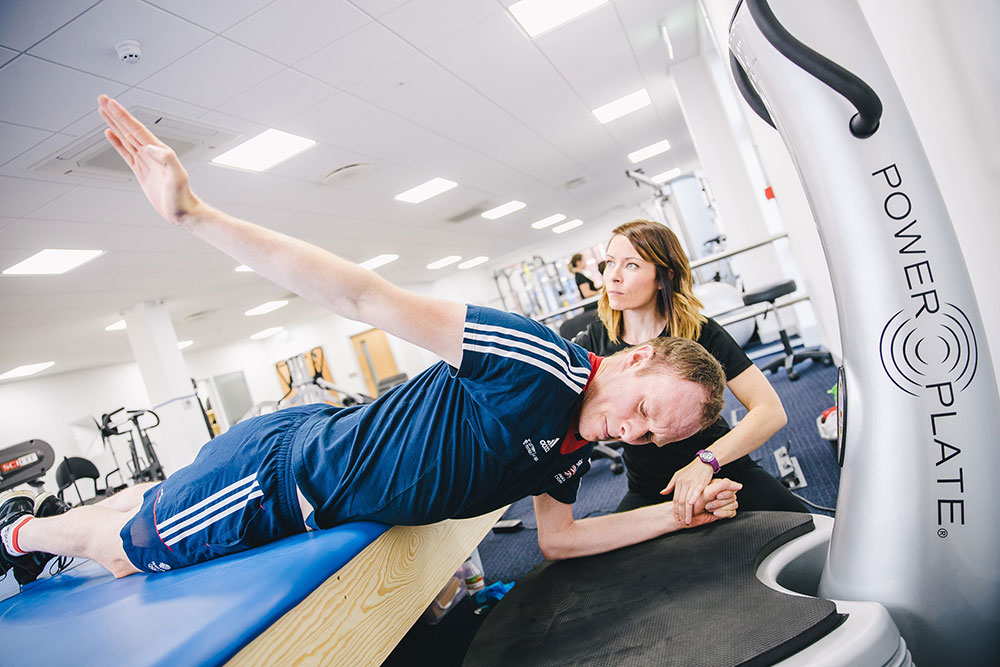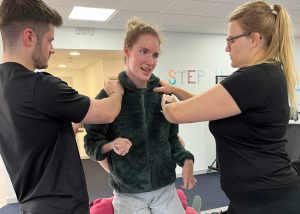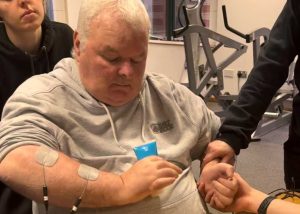David has survived not one, not two but three life-saving operations to remove a recurring spinal cord tumour in his neck. Undeterred by the physical and psychological challenges he has faced, David is now working with Neurokinex to restore mobility, strength and feeling after his most recent surgery in May 2016 left him paralysed down his left side.
David is no stranger to challenge and change: in his sporting career he has competed for his country in sports as diverse as able-bodied karate (1993-1999), Bobsleigh (2002-2008) and Paralympic rowing which he took up in 2009. He won Gold in the mixed coxed four at the London 2012 Paralympic Games and is now in training with the GB cycling programme.
How it started
David’s spinal cord tumour was initially discovered in May 2010 during a routine physio session which revealed an abnormal reaction in his neck. Tests revealed he had a tumour which was crushing his spinal cord. He had surgery on May 14, 2010 and within five months was back to training. Fourteen months after leaving hospital, David won the World Rowing Championships before going on to win Gold at the London 2012 Paralympic Games. This was a golden year which also saw him awarded an MBE.
But the good fortune didn’t last. In 2014 his tumour returned and David faced further surgery. He returned to the John Radcliffe Hospital where his surgeon, Tom Cadoux Hudson, operated a second time. David knew he couldn’t return to rowing so set his sights on cycling. From his hospital bed he planned how he would train for an incredible cycling feat – to cycle up Mont Ventoux three times – up each of the mountain roads that can be taken to the summit. Not only did the Mont Ventoux challenge push David to his limits, his achievement also caught the eye of GB Cycling and he was accepted onto their programme with Rio 2016 Paralympic Games firmly in their sights.
Back in the saddle for GB Cycling
David worked hard on his cycling-specific rehab at Bisham Abbey as he fought back to fitness. He was nicely on target to make the team for Rio when his genetic tumour returned once again in September 2015. It was then about 3mm inside the spinal cord where there was only 8mm space. David wanted to train on for Rio and have the surgery after the Games. However, in January 2016 he came off his bike in training at 30mph and a scan revealed not only was the tumour bleeding but it was close to the nerves that supply David’s lungs: he couldn’t wait for surgery. On March 2, the Road to Rio ended for David when he woke from the surgery to find he was completely paralysed through the left side of his body. As before, David had set himself a cycling challenge to train for and he planned to cycle the 700KM Les Alpes route from Lake Geneva to Nice. Week after surgery in the John Radcliffe David asked to be taken down in the wheelchair to sit on the bike in the rehab gym where he cycled for half an hour. He told the nurse there that he was going to cycle the Les Alpes route, but it was clear he wasn’t convinced David could do it.
Ground-breaking technology
David left Stoke Mandeville on June 10, 2016 and entered Neurokinex on crutches at the start of July. “Within a week I believed that if anyone could get me back to fitness, this team could.”
David is working intensively at Neurokinex in four-week phases, five days per week and four hours each day. “They push me for hard for four hours every day without a break, but I have seen massive improvements. The whole set up is incredible but there are two key pieces of kit that have transformed my rehab here,” says David. “Luckily for me, Neurokinex works closely with the Christopher & Dana Reeve Foundation’s NeuroRecovery Network (NRN) and have two of its unique protocols in place at the Gatwick site where I train. If Neurokinex didn’t have this kit and knowledge, I’d have to fly to the US to access it.”
The first piece of equipment David is using is the Powerstep Locomotor Training system which is helping him learn to walk well again and re-establish a balanced gait following his paralysis. Locomotor Training emerged from recent advances in the understanding that the spinal cord can interpret sensory information below the level of injury and relay signals to generate a motor response. Locomotor Training works to awaken dormant nerve pathways by repetitively stimulating the muscles and nerves in the lower body and thus retrain the spinal cord to ‘remember’ the pattern of walking.
The second unique NRN protocol David uses is the NeuroMuscular Electrical Stimulation (NMES) programme which targets muscle fibres closely connected to the spinal cord. This, combined with the precise administering of the electrical stimulus to move the muscle or paralysed limb, excites the central nervous system in such a way it can promote neuroplasticity – the brain’s ability to form new neural connections to compensate for injury. David is using this primarily on his paralysed left shoulder and arm to restore feeling, movement and strength.
Results are ‘blown out of the water’
“The range of equipment at Neurokinex is incredible and the team’s expertise and energy are extraordinary,” says David. “Their knowledge and skill is second to none: they have me working on a wide range of fitness and rehab machines including Power Plate vibration training, Total Gym incline training, Cybex fixed pulleys and all manner of other things. It’s remarkable what I can do.”
David is combining his work at Neurokinex with time at Bisham Abbey where GB cycling continue with his sports-specific programme. “Each time I return to Bisham Abbey my results have been blown out of the water – improving 100% each time,” says David. “I can feel and see the improvements but the independent verification from Bisham Abbey is proving beyond doubt the incredible progress I’m making at Neurokinex.
“The transitions in rehab are psychological and emotional as well as physical and the trainers at Neurokinex understand this,” says David. “There is an astonishing energy among the team: you can feel it when you walk through the door. I have so much respect for them and I trust them implicitly. All I can say is I couldn’t walk properly without a stick when I joined Neurokinex and now I can. I was paralysed and now I can feel a really good contraction in my arm. There is so much research going into spinal cord injury and we are getting close. Neurokinex is at the centre of these developments in the UK and I’m just so grateful our paths have crossed.
“From paralysis to walking and a wheelchair to cycling 700KM across the Alps may seem impossible: but with Neurokinex anything is possible.”




